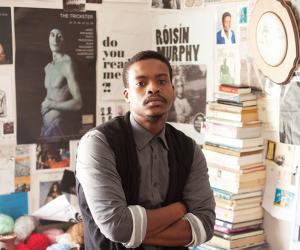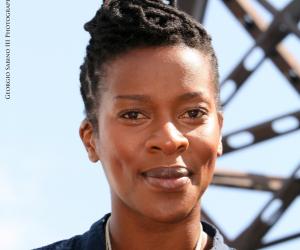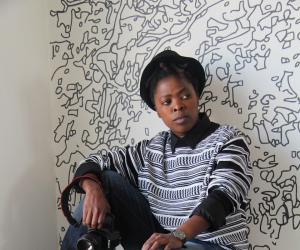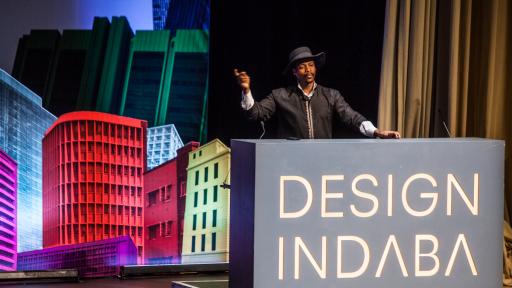"State of the Art", a special feature on the Design Indaba Conference 2014 programme, shines a spotlight on three contemporary South African artists. In this video, the three present their work and subsequently engage in an exchange on stage with Hans Ulrich Obrist, co-curator of the Serpentine Gallery in London.
Athi-Patra Ruga
First up is Athi-Patra Ruga, a performance artist who explores the border-zones between fashion, performance and contemporary art. Ruga explores notions of utopia and dystopia through multiple media, such as performance, video, textiles and print.
Ruga introduces the audience to a fictional place called Azania, a mythical construct of his own imagination that has played a central role in his work. “Azania stretches from the Horn of Africa down to the Cape Agulhas. It’s a constitutional monarchy with a versatile queen. The entire population is made up of females,” says Ruga. He created the myth of Azania through performance, highlighting the many different disciplines of performance present in this imaginative world.
Ruga created a character, the White Woman of Azania, to bring to life his vision. “You might wonder why she is white? Because for me, white does not represent a race,” says Ruga. She was born in Argentina, moved to Berlin. She worked in Kenya and Cape Town, before settling in Azania. Ruga constructed her out of latex, tinsel, powder and water to represent an identity based on air.
Ruga goes on to explain that Azania is a metaphor for South Africa. “Azania is what took people through the hardest times in South Africa. It’s a promise of utopia, a promise of working together towards a united place, it’s something that made people keep fighting for human rights and equality,” he says.
In 2010, he ventured into performance art with his first piece set in Argentina. He constructed a costume for it that he wore to embody the White Woman of Azania.
The most important question is what am I doing this for? I am doing it so that we all feel as though you have a place in my body. My body becomes a landscape where we all exist together in a place that belongs to us all.
Nandipha Mntambo
Second up on the "State of the Art" programme is award-winning artist Nandipha Mntambo. Mntambo uses sculpture, video and photography to explore themes related to the female body and female identity.
The work I create seeks to challenge and subvert preconceptions regarding representation of the female body, says Mntambo.
Her 2007 project Silent Embrace explores how a viewer might respond to a female body completely covered in hair. Mntambo created a sculpture of her mother’s body and covered the mould with cowhide. “I use cowhide as a means to subvert expected associations with femininity, sexuality and vulnerability.”
Her photographic projects Europa and The Rape of Europa stem from her interest in mythology: “The projects are inspired by the animal/human and its century-long fascination for civilisation”, she says. Working alongside photographer Tony Meintjies, the duo created a fictional woman based on Mntambo. “Europa and The Rape of Europa look at how we can all come to terms with elements that we don’t like about ourselves.”
Another project,Pra ça de Touros, centres on Mntambo’s interest in understanding how we protect ourselves, as opposed to engaging in fighting. Spending time in Spain and Portugal, she taught herself the art of bullfighting by job-shadowing professional bullfighters. Praça de Touros includes a video piece filmed in a desolate bullfighting arena in Mozambique, where she acts out the roles of fighter, animal and audience.
Zanele Muholi
The third featured artist is Zanele Muholi, a photographer and visual activist whose work shines a critical light on lesbian, gay, bisexual, transgender and intersex (LGBTI) discrimination. Speaking against the backdrop of homophobia in Africa, Muholi encourages the audience to help her oppose the recently instated Anti-Sexuality Bill in Uganda, which makes same-sex relationships illegal. She further encouraged the audience to love and accept LGBTI individuals.
The kind of work I do is on queer politics, gender politics and politics of race, says Muholi.
A firm believer in collaboration, Muholi shows a documentary to illustrate how she works. The video, We Live in Fear, is set in the Kwa-Thema informal settlement outside Johannesburg and reveals how LGBTI individuals and communities are targeted by hate crimes such as “curative rapes” and lesbian murders. Muholi stresses the need to document these crimes and recognise the lives of LGBTI individuals as these communities deserve their history to be preserved too.
In 2009, Muholi founded Inkanyiso, a visual media platform dedicated to queer content that is often missing from the mainstream media. The blog produces videos, photographs and articles that capture the realities of LGBTI cultures. Furthermore, Inkanyiso speaks out against hate crimes aimed at LGBTI individuals and seeks to make mainstream communities aware of its severity: “Hate crimes have become a binding factor for the LGBTI community but what are we all going to do about it?” she asks.
Muholi hopes her work brings about change in spaces that are “queer-phobic”.
If I wait for someone to validate my existence, it will mean I am short-changing myself, she says.
After their presentations, Ruga, Mntambo and Muholi discuss issues common to their work, such as the importance of activism, their unrealised projects and who their mentors and heroes are.












